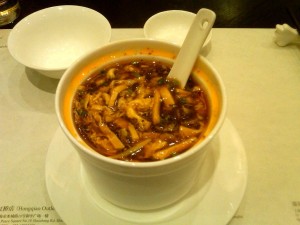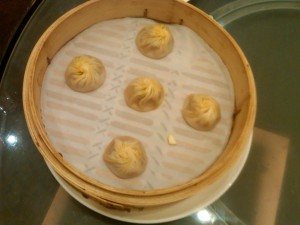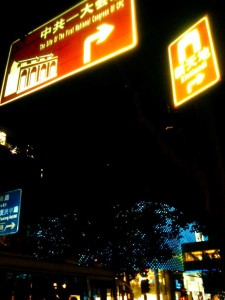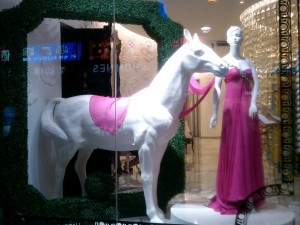 Because you have to eat–well actually because it is the one sure high point in a very long trip full of meetings and really weird cultural miscommunication at work–we went to Din Tai Fung last night for dinner. It’s the Taiwanese (actually started by Shanghainese people in Taiwan) dumpling chain that is the temple for soup dumpling lovers. We always go to the Xintiandi location, which is in a luxury mall that as it happens was hosting a Taiwan fashion show last night. In a surprise move, the top dish of the evening was probably this steaming ewer of hot and sour soup–even better than the sublime xiaolongbao (dumpling-like pouches with pork and crab and hot broth inside). Now normally this is not something you would bother to order as at most American Chinese restaurants it is watery, neither spicy nor hot, in all respects not even as satisfying as your basic won ton soup. But this is a truly robust specimen that as you can see is a) made with a thick broth, b) jammed with firm noodles and tofu threads that they did not get out of a can, c) really pungent with spices. Not visible is the teaspoon or so of pepper that was just sitting on the top before being stirred in.
Because you have to eat–well actually because it is the one sure high point in a very long trip full of meetings and really weird cultural miscommunication at work–we went to Din Tai Fung last night for dinner. It’s the Taiwanese (actually started by Shanghainese people in Taiwan) dumpling chain that is the temple for soup dumpling lovers. We always go to the Xintiandi location, which is in a luxury mall that as it happens was hosting a Taiwan fashion show last night. In a surprise move, the top dish of the evening was probably this steaming ewer of hot and sour soup–even better than the sublime xiaolongbao (dumpling-like pouches with pork and crab and hot broth inside). Now normally this is not something you would bother to order as at most American Chinese restaurants it is watery, neither spicy nor hot, in all respects not even as satisfying as your basic won ton soup. But this is a truly robust specimen that as you can see is a) made with a thick broth, b) jammed with firm noodles and tofu threads that they did not get out of a can, c) really pungent with spices. Not visible is the teaspoon or so of pepper that was just sitting on the top before being stirred in.
It was a lovely way to herald a succession of steamer baskets that were borne to our table  with piping hot, precisely arranged “classic,” pork, shrimp, and chicken soup dumplings plus veggie dumplings. You carefully remove them from the basket with your chopsticks, dip them into some vinegar, soy sauce and ginger, and put reverently into your mouth.
with piping hot, precisely arranged “classic,” pork, shrimp, and chicken soup dumplings plus veggie dumplings. You carefully remove them from the basket with your chopsticks, dip them into some vinegar, soy sauce and ginger, and put reverently into your mouth.
As we walked through a sort of Chinese luxury Vegas-like outdoor adult playground afterwards, and then over to the main drag of Xintiandi that features giant, pulsating blue buildings that hold the Apple Store, Louis Vuitton and other socialist worker collective outlets, my Shanghai-born colleague pointed out the wonderful irony of this particular street sign.  It points out the nearby birthplace of the Chinese Communist Party–which is literally next door to the luxury mall–and just beyond it you can see the blue temple of iPads beckoning. There are many reminders that probably no other city has changed so much in the past few decades as Shanghai. A cute fluffy white dog was playing in a grassy area in front of Louis Vuitton and my colleague said that 30-40 years ago, the only pets allowed in Shanghai were cats. This was also a time when the Party elite and their children were not so much better off than the common working stiff. You would never know it walking down the streets of central Shanghai, but beneath the genial surface of anyone over a certain age lies stories of incredible hardship and struggle. If you are interested in a Western view into the Cultural Revolution era and its aftermath, I highly recommend a book by John Pomfret, former Washington Post bureau chief in Beijing, called Chinese Lessons: Five Classmates and the Story of the New China. Pomfret was a foreign exchange student at Nanjing University in 1981, the first year that Americans were allowed to do such exchanges. His book tells the stories of his roommates that year: their lives leading up to university and in the 25 years afterwards.
It points out the nearby birthplace of the Chinese Communist Party–which is literally next door to the luxury mall–and just beyond it you can see the blue temple of iPads beckoning. There are many reminders that probably no other city has changed so much in the past few decades as Shanghai. A cute fluffy white dog was playing in a grassy area in front of Louis Vuitton and my colleague said that 30-40 years ago, the only pets allowed in Shanghai were cats. This was also a time when the Party elite and their children were not so much better off than the common working stiff. You would never know it walking down the streets of central Shanghai, but beneath the genial surface of anyone over a certain age lies stories of incredible hardship and struggle. If you are interested in a Western view into the Cultural Revolution era and its aftermath, I highly recommend a book by John Pomfret, former Washington Post bureau chief in Beijing, called Chinese Lessons: Five Classmates and the Story of the New China. Pomfret was a foreign exchange student at Nanjing University in 1981, the first year that Americans were allowed to do such exchanges. His book tells the stories of his roommates that year: their lives leading up to university and in the 25 years afterwards.
Perhaps no place symbolizes the new China like the Bund, the strip of luxury hotels and palace-like banks along the river in Shanghai which has a beautiful pedestrian walkway looking out on Pudong, a forest of skyscrapers across the river that was a fishing town 25 years ago. Tens of thousands of Chinese were out walking along and taking photos this evening. Sadly, we had to go to a conference dinner, which did not feature rubber chicken but did serve up both jellyfish and sea cucumber. We walked on the Bund and then down pedestrianized Nanjing Road, which is kind of like the new Times Square. It is all neon and hordes of wide-eyed gawkers, plus hawkers. Thinking of my girls, the most compelling vision was this bridal salon featuring a beautiful bride-horse pairing in pink. If Dora could marry My Little Pony, this is what she’d wear. 

When we were in China 3-4 years ago, Julie and I visited some art galleries in the 789 District in Beijing. There were some oddly themed paintings and sculptures of policemen beating on dogs and it was explained to us that during the 70s and early 80s, the government had a crackdown on large dogs and basically took them away and killed them. One of those bits of cultural history that doesn’t make it outside the Great Wall.